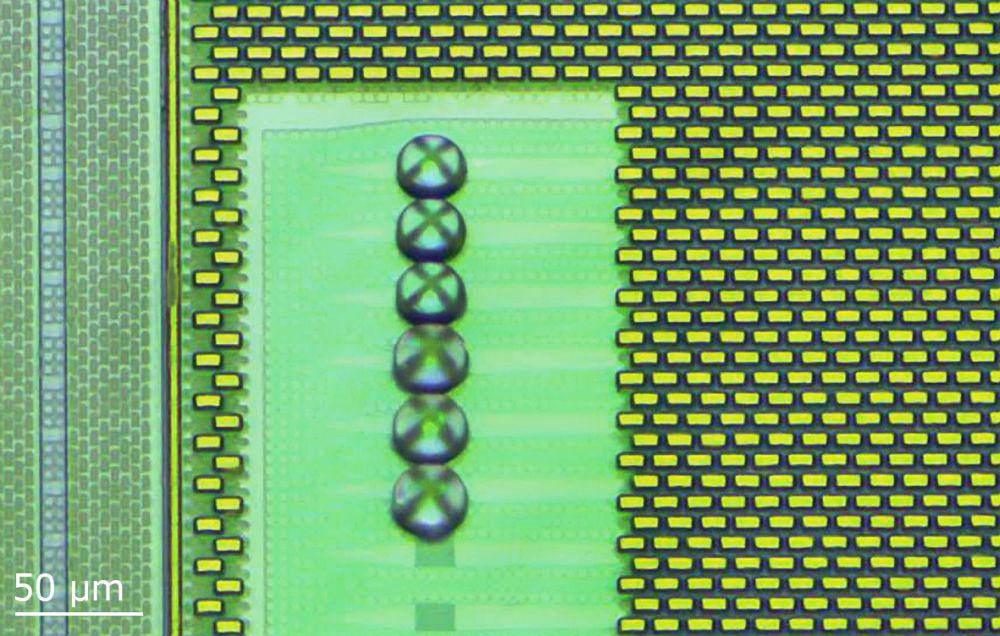On-Chip 3D Microprinting for Photonic and MEMS Systems

Growing demands on high-speed data communication, unmanned aerial vehicles and portable medical devices are attracting industries to new manufacturing methods like, for example, Nanoscribe's direct laser writing technology. Currently, the production of photonic circuits and microelectromechanical systems (MEMS) needed for these applications requires different manufacturing methods and multiple process steps for bringing together various components on one microchip. Now, with Nanoscribe's highest resolution 3D printers one can print and integrate microscopic components directly on integrated circuits such as micro-lenses onto photonic circuits and deformable structures on microelectromechanical systems (MEMS) actuators. With this groundbreaking technique smallest objects with complex geometry and feature sizes from hundreds of nanometers up to several millimeters can be printed. They are produced in a single printing step and on a scale which was inaccessible to 3D printing before. This major update of on-chip printing brings new perspectives for producing nano- and microscale 3D components in situ, exactly where needed.
For this 3D printing process, Nanoscribe's Photonic Professional GT system uses the method of two-photon polymerization. The precision optics and advanced software tools of this 3D printer allow to fabricate 3D polymer structures with submicron precision, making the strengths of additive manufacturing available to micro- and nanofabrication. These advantages are the full 3D design freedom and a simple workflow from CAD model to final part resulting in rapid design iteration cycles that save time and costs during product development. Additionally, the wide choice of print surfaces now also includes pre-patterned chips making miniaturization of 3D functional parts into highly integrated circuits possible.
In the attached movie Nanoscribe demonstrates the printing of micro-lenses onto photonic chips for the first time (Img 1). A series of hemispherical micro-lenses were fabricated on top of grating couplers previously patterned on a photonic chip (Img 2). This way, an array of micro-lenses can couple light into the circuit. The micro-optics were created in one printing step and without the need to align and mount the finished micro-optics mechanically into the pre-structured microchip. This process of direct fabrication of components onto existing circuits reduces packaging costs in equipment and saves time in calibration. Moreover, it avoids pick and place as well as curing-based fixing procedures. Taking advantage of the laser accuracy, 3D microprinting also offers submicron precision and optical quality surfaces meeting the requirements for high performance micro-optics. Altogether, these benefits make this manufacturing technique a valuable method for in situ fabrication of micro-optics onto photonic integrated circuits for higher data transfer in telecommunication.
3D printed micromechanical components on MEMS actuators
Applications in medical imaging, tissue regeneration and MEMS actuators can benefit from the fabrication of integrated circuits. For example, Nanoscribe customers at the Boston University, headed by Professor Alice White, fabricated 3D deformable bowtie-like structures directly on MEMS actuators (Img 3). The 3D printed micromechanical bowties are structures that stretch and deform in 3D due to their geometry. The scientists were able to deform the microstructure by applying a voltage to the MEMS actuator. Professor White states: "We show that coupling 3D microprinting with MEMS actuators is a powerful way to produce 3D micromechanical systems tailored to specific needs. Nanoscribe 3D printers allow us rapid prototyping of submicron-resolution structures that would otherwise be impossible to fabricate via single-photon stereo-lithography or the deposition and etching processes commonly used in semiconductor foundries." Their results will potentially find applications based on the dynamic actuation of 3D printed microstructures such as deformable optics and scaffolds for tissue engineering.
The integration of microscopic components into photonic and MEMS systems is one of today's challenges in manufacturing and packaging. Together with this kind of miniaturization more and more functional parts have to be accommodated in ever smaller spaces. Solving this challenge with the use of advanced 3D microfabrication tools will open the way to commercial applications from high-speed data transfer and telecommunication to mobile devices for healthcare.
Technology behind on-chip 3D printing
The two-photon polymerization process is the basis for Nanoscribe's 3D microprinting technology. In this printing process a laser exposes a photosensitive resin by means of a high-numerical aperture objective in a controlled trajectory and layer-by-layer following a CAD design. The material solidifies only in the laser focus spot allowing for nearly 3D arbitrary structures with even submicron features. The new update of this technique expands the scope of use for printing on pre-manufactured circuits and opens new avenues for on-chip printing.



































